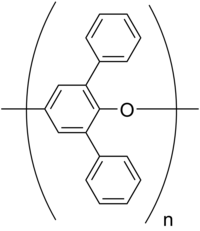Poly (2,6-diphenyl- p -phenylene oxide )
| Structural formula | |||||||
|---|---|---|---|---|---|---|---|

|
|||||||
| General | |||||||
| Surname | Poly (2,6-diphenyl- p -phenylene oxide ) | ||||||
| other names |
|
||||||
| CAS number | 24938-68-9 | ||||||
| Monomer | 2,6-diphenyl- p- phenylene oxide | ||||||
| Molecular formula of the repeating unit | C 18 H 12 O | ||||||
| Molar mass of the repeating unit | 244.29 g mol −1 | ||||||
| properties | |||||||
| Physical state |
firmly |
||||||
| Melting point |
480 ° C |
||||||
| Glass temperature |
235 ° C |
||||||
| safety instructions | |||||||
|
|||||||
| As far as possible and customary, SI units are used. Unless otherwise noted, the data given apply to standard conditions . | |||||||
Poly (2,6-diphenyl- p- phenylene oxide ) is a polymeric adsorbent resin.
The compound was originally patented by General Electric as an electrically insulating polymer. The AkzoNobel developed it under the brand name Tenax as column packing material for gas chromatography . For the first time, it was also used on board the Skylab 4 as an adsorbent for pre-concentrating volatile organic compounds . Today it is one of the standard adsorber materials used in air studies.
synthesis
Poly ( p - 2,6-diphenylphenylene oxide ) is made by the oxidative coupling of 2,6-diphenylphenol .
properties
Poly (2,6-diphenyl- p- phenylene oxide ) is temperature stable up to 400 ° C. Commercially available poly (2,6-diphenyl- p- phenylene oxide ) consists of highly porous particles with an average size of 200 μm. The surface is 20 to 35 m 2 · g −1 .
Also, polydimethylsiloxane (PDMS) can be used.
Individual evidence
- ↑ a b Dirk Willem van Krevelen : Development tendencies in the chemical fibers . In: Lenzinger reports . No. 32 , December 1971, p. 10-20 ( PDF ).
- ↑ This substance has either not yet been classified with regard to its hazardousness or a reliable and citable source has not yet been found.
- ↑ K. Sakodynskii, L. Panina, N. Klinskaya: A study of some properties of Tenax, a porous polymer sorbent . In: Chromatographia . tape 7 , no. 7 July 1974, p. 339-344 , doi : 10.1007 / BF02269347 .
- ↑ a b Bassam Alfeeli, Vaibhav Jain, Richard K. Johnson, Frederick L. Beyer, James R. Heflin, Masoud Agah: Characterization of poly (2,6-diphenyl-p-phenylene oxide) films as adsorbent for microfabricated preconcentrators . In: Microchemical Journal . tape 98 , no. 2 , July 2011, p. 240–245 , doi : 10.1016 / j.microc.2011.02.006 ( PDF ).
- ↑ Stefan Degen: Development of a measuring method based on thermal desorption for the detection of low-volatility hydrocarbons in trace concentrations with gas sensors . Dissertation, University of Münster 2001, DNB 967411173/34 . Section 3.2 Sample enrichment in the adsorption process
- ↑ Patent US3432466 : Process of making poly- (2,6-diaryl-1,4-phenylene ethers). Filed November 14, 1966 , published March 11, 1969 , Applicant: General Electric, Inventor: Allan S. Hay .